What are Golf Clubs Made of? (FIND OUT!)
Golf clubs are made of various materials, such as wood, aerospace-grade stainless steel, titanium, carbon steel, and carbon graphite, such as carbon fiber. In many cases, a golf club may be made out of a combination of 2 or 3 materials as well.
To maximize playability, distance, and comfort, the use of the right material is essential when it comes to golf clubs. And to understand more about this, keep reading!

What Are Golf Clubs Made Of?
Over time, golf clubs have been made out of many types of material. In the modern era, more and more use of carbon graphite can be noticed. Especially with companies such as Ping.
However, aerospace-grade stainless steel remains the most used material to make golf clubs to this day.
With that being said, there are other materials used to make golf clubs too, let’s talk about them more in detail:
1. Golf clubs made out of wood
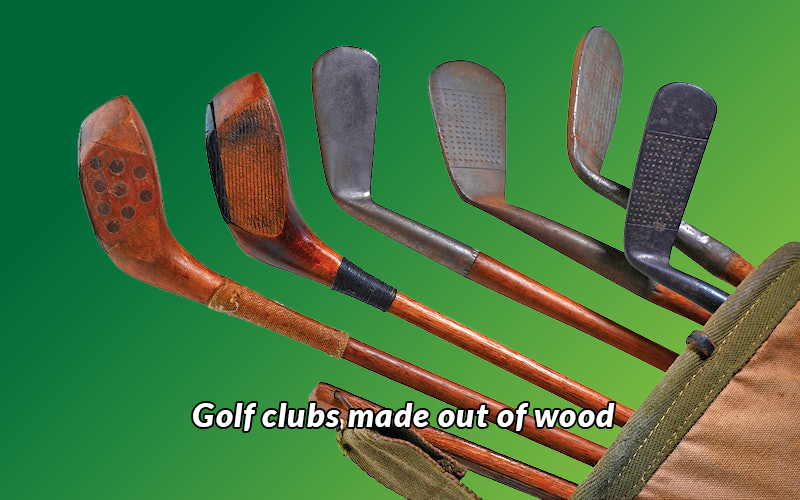
Golf clubs made out of wood are usually called woods. They are pretty similar to golf drivers as their main purpose is to help you achieve maximum distance toward the hold on your first hit.
Persimmon wood is the most famous type of wood used to make wood. Nowadays, woods have become a lot more rare as most drivers are made out of metal alloy or carbon fiber.
This also makes drivers and fairway wood made out of wood material quite expensive and hard to find!
2. Golf clubs made out of titanium
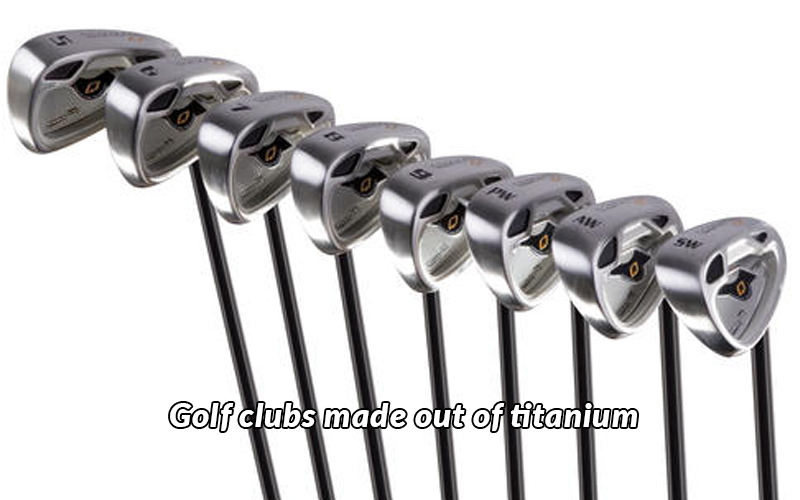
Since the early 1990’s titanium has been the most popular material used while making golf clubs.
Clubs made out of titanium are not only strong but also flexible and light. The perfect combo for top golfers.
Titanium golf clubs are covered by 90% 6/4 titanium alloy. While the other 10% is covered by aluminum and vanadium.
To add more weight another form of aluminum called ‘beta aluminum’ is often used as well.
3. Golf clubs made out of stainless steel
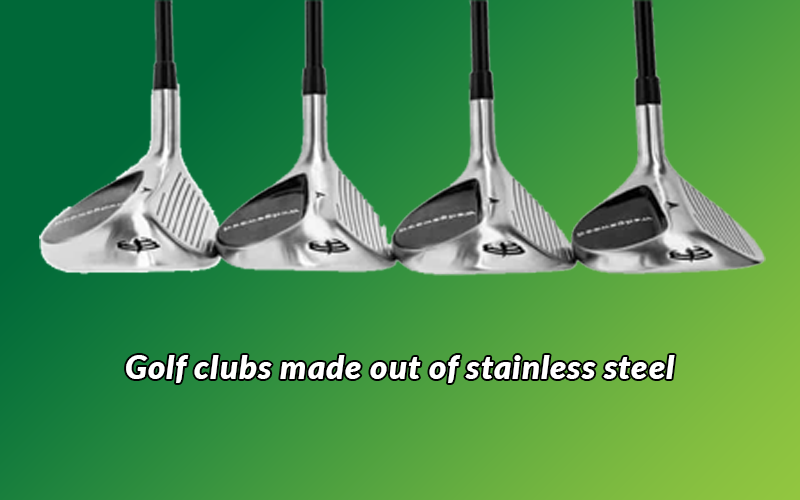
The most common and preferred material to make golf clubs is stainless steel. Not only is it pretty sturdy but it costs less and is easier to cast.
This is why stainless steel is used in most types of golf clubs ranging from fairway woods, irons, putters, and hybrid.
Essentially two types of stainless steel are used to make golf clubs. One is a 17-4 grade stainless steel and the other is 431 grade. Here are the elements for both grades:
- 17-4 grade stainless steel:
- Carbon: 0.07%
- Chromium: 15-17%
- Nickel: 4%
- Copper: 2.75%
- Iron and trace elements: 75%
- 431-grade stainless steel:
- Carbon: 0.02%
- Chromium: 15-17%
- Nickel: 1.25-2.05%
Copper, iron, and trace elements make out the rest.
Amongst both grades of stainless steel, the 431 is lighter than the 17-4. This is why the 431 is a bit more adjustable in terms of loft and lie.
4. Golf clubs made out of maraging steel

Maraging steel is of the same family of stainless steel. The only big difference is, it’s a bit harder than stainless steel. But, it’s also much more malleable.
Its unique properties make it quite expensive, similar to titanium. Maraging steel is mostly used as inserts for a club head. However, it can be used to make a whole club head too.
As it’s hard but malleable, the club heads can be made thinner than usual clubs. This allows the ball to have a higher velocity upon exit than usual stainless steel clubs.
5. Golf clubs made out of aluminum
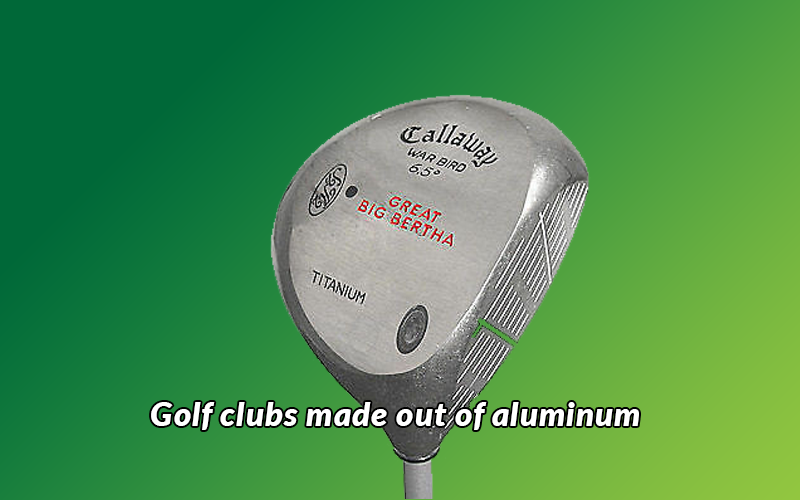
Aluminum is a popular alloy when it comes to making drivers. Mainly, low-cost drivers.
Aluminum is comparatively cheaper than stainless steel and titanium. It’s also much lighter.
With that being said, the performance compliments the price pretty well.
But, drivers made out of aluminum are known to produce less speed in the exit as aluminum clubs need thicker walls to avoid breakage.
6. Golf clubs made out of carbon steel
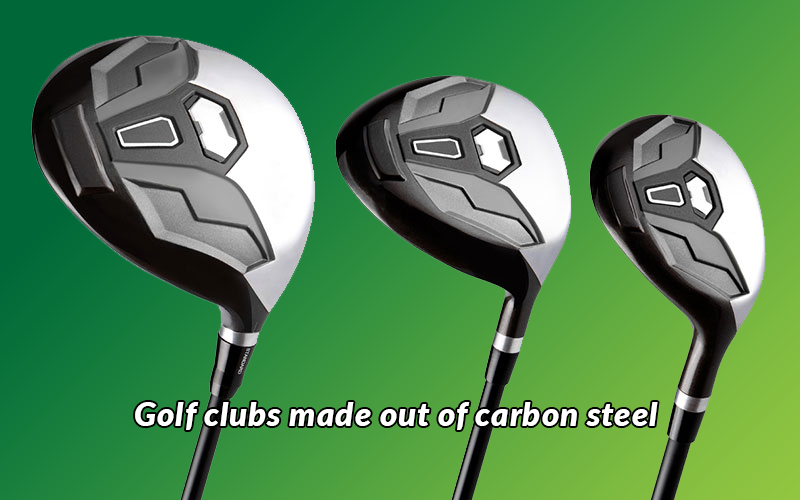
Carbon steel clubs are more expensive than stainless steel clubs. These clubs are also made for more seasoned golfers.
Lower handicap golfers claim a noticeable improvement in feel and spin. Irons, wedges, and putters are all produced using this alloy.
And is known to be more of a ‘preference golf club’ as most players don’t see a noticeable difference.
7. Golf clubs made out of carbon fiber

Companies such as Ping are famous for their carbon fiber-made golf drivers. Carbon fiber allows the club to be super light while still being thick in its frame.
As golf drivers or woods need to be thicker in its head, light material is essential.
A lighter golf driver or wood allows the players to achieve maximum distance through their swing speed.
But if you have a slower swing speed don’t worry! Because with carbon fiber the club head weight can be manipulated as per preference.
Carbon fiber is also being implemented to make other types of clubs. However, the drivers are the ones showing the most promise. Carbon fiber clubs are also known to be quite expensive.
How are Golf Clubs Constructed?
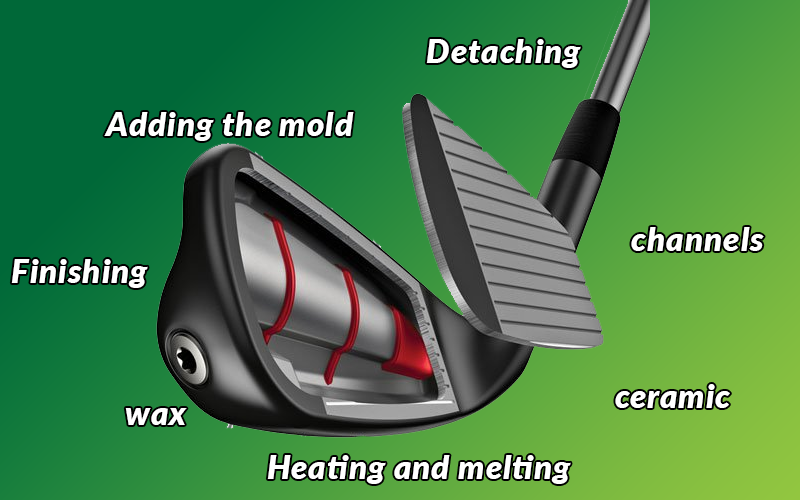
Now that we’ve talked about what golf clubs are made of, let’s learn how the clubs are constructed. Nowadays with the use of carbon fiber, the process has become even harder.
As getting just one calculation wrong can cause the club to perform very poorly. So, let’s look at how clubs are constructed with a metal alloy:
Step 1: Creating wax replicas of the head
First, the workers pour hot wax into a mold to create replicas of the club heads.
These replica heads are used to create ceramic molds in which molten metal is cast as per the preferred shape.
Step 2: Creating channels for the casting mold
Now using a robot, gates, and runners are created into the wax club heads. These gates and runners will work as entrance ways through which the molten metal is poured.
Step 3: Creating ceramic molds of the club heads
Using a robot the wax replicas are dipped in a liquid ceramic material 4-5 times. Between each coat, silica sand is showered on the mold to harden the shell.
Step 4: Washing off the wax
Now, the robot will wash off the wax replica leaving out a hollow shell made out of liquid ceramic material and silica sand. This hollow mold can now be used for casting the irons.
Step 5: Heating and melting the components
Using a furnace metal bars are melted at 1635 degree Celsius, completely melting the metal into liquid.
In another furnace, the ceramic molds are heated to 980 degrees Celsius. This not only hardens the molds to be able to withstand the molten metal but also removes any remaining wax.
Step 6: Adding the mold
Now, the molten metal is added to the ceramic mold. The pouring of the metal should be consistent enough to avoid the formation of bubbles. The mold will be let to rest for five hours.
Step 7: Detaching the club heads from the access mold
After five hours the mold takes a solid form, which is broken down with the help of a robot.
Then the gates and runners are removed to detach the club head from the mold.
Next, the club heads are ground with a sandblaster, and given the shiny finish, we all love it!
Step 8: Finishing off
The last step is to add the model number, club number, brand badge, color coding, and shaft installer.
To add the shaft to the club head, epoxy is used. And using a pneumatic hammer, the shaft is pushed and attached perfectly.
Then using laser liners, the grips are attached. The grips must be lined up perfectly!
Read More
- Taylormade M4 Vs M6 Golf Driver: Which One Reigns Supreme?
- Titleist 917 D3 vs. Taylormade M1: Ultimate Driver Showdown
- TaylorMade P760 vs. P790: Which Golf Irons to Choose?
- Callaway Apex 21 vs. Taylormade P790: Which Iron to Choose?
- Callaway Epic Max vs TaylorMade Epic SIM2 Max Driver: Which One Fits Your Needs?
Frequently Asked Question?
To round up today’s topic, here are some frequently asked questions! These questions will help remove any remaining confusion you may have.
Are wood-made golf clubs still produced?
Wood-made golf clubs are extremely rare to find these days. You may still be able to find them as antique pieces and custom club manufacturers. However, the prices are much more likely to be very high.
Which material is the best to make a golf club?
Most producers prefer maraging steel while creating golf clubs! And while carbon fiber allows the most freedom while making a golf club, stainless steel, and titanium are still preferred by golfers! However, it’s more on preference. For the most part,
Final Words
Over the last hundred years, the materials used to make golf clubs have evolved quite a bit!
The goal has always been the same, to create the best clubs using the most sustainable materials.
While stainless steel and titanium are still dominating the market, carbon fiber is showing great potential!
Overall, we hope you were able to learn something new today from our article! Until next time, goodbye!
Reference: https://en.wikipedia.org/wiki/Golf_club
Meet Jalal, a passionate golf writer and the driving force behind Golfertroop.com, your go-to destination for all things golfing! Whether you’re a seasoned golfing veteran or a beginner taking your first swing, Jalal is here to assist you in making the most out of your golfing experience.






